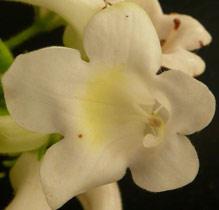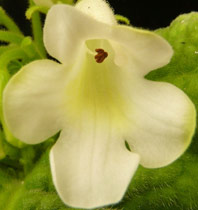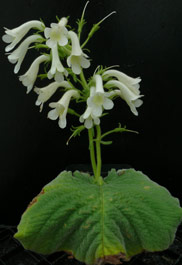Streptocarpus vandeleurii
Streptocarpus vandeleurii Baker f. & S.Moore
Family: Gesneriaceae
Common names: olifantsoor (Afr.)
Introduction
This is an unusual herbaceous plant that consists of only one leaf with an impressive inflorescence of creamy white flowers that will die once it has flowered - a real challenge to prospective growers.

Description
Description
A herbaceous plant consisting of only one large leaf (unifoliate), which grows up to 300 mm long and is as wide, is deeply furrowed, hairy above and below. No stems are present, so the leaf itself is actually an individual plant with its own roots and flowering stem. The plant is also monocarpic, meaning it will die after flowering and fruiting.

The tall inflorescence stalk, 300 mm long, arises from the heart-shaped leaf base and bears a large cluster of up to 36 strongly scented creamy white flowers, many of which are open simultaneously. Flowers of all Streptocarpus species have a tiny five-lobed calyx backing a tubular corolla that flares out into a five-lobed mouth. The flower typically has two lips, the upper is 2-lobed and the lower 3-lobed. Streptocarpus vandeleurii has a distinctive yellow blotch at the base of the lower corolla lip. The long fruit capsules, which feel velvety when young, twist open in a spiral when dry, releasing lots of very small light seeds.

Some other interesting facts are:
- This species is unifoliate = has only a single leaf
- This species is also monocarpic = it will flower, set seed, then die
- The flowers are zygomorphic = asymmetrical, so can only be cut in one plane to give two identical halves
The shallow root system allows many of the members of the Gesneriaceae to grow successfully as epiphytes, growing on the trunks of trees; or terrestrially, in the ground soil or in leaf litter on the forest floor; or as lithophytes, growing in thin layers of moss or humus on rocks. This species prefers the latter.
Conservation Status
Status
Streptocarpus vandeleurii is listed on the Red List of South African plants, in the category Least Concern. Many of the Streptocarpus species are very specific in their distribution and occur in very small populations, making them vulnerable to any disturbance.
Distribution and habitat
Distribution description
Grows in the crevices of rocky outcrops or on the sides of damp kloofs on rocky ledges in the North-West Province, Mpumalanga and Gauteng.
Derivation of name and historical aspects
History
The name Streptocarpus is derived from the Greek words streptos meaning twisted and carpus meaning fruit, which is a perfect description of the plant's twisted seed pods. The specific epithet vandeleuriiis named after C.B. Vandeleur (1867-1947), an English soldier who made the first recorded collection of this plant in 1900 at Greylingstad while stationed in the Transvaal, now Gauteng.
Streptocarpus belongs to the same family, Gesneriaceae, as do the well known African violets and gloxinias that are grown as pot plants all over the world. This is a large family of mostly tropical and subtropical herbs, with ± 139 genera, and ± 2 900 species worldwide. There are 8 genera in Africa, with only one genus, Streptocarpus, of which ± 51 species occur in South Africa. The family, Gesneriaceae, was named after Konrad Gesner, a Swiss scholar, 30 years after his death, in 1763.
Ecology
Ecology
The pale colour of the flowers and the strong evening scent indicate a strong probability that they are moth-pollinated. The very small seed is wind-distributed.
Uses
Use
Streptocarpus hybrids are very popular indoor pot plants, particularly overseas. It is interesting to note that only a few species were used as parent plants in order to develop the hybrids available today. With such great variation within species which easily hybridize, there is still much scope to develop completely new hybrids. There is much interest and a growing demand for Streptocarpus in South Africa.
Growing Streptocarpus vandeleurii
Grow
Streptocarpus vandeleurii is not as easy to grow as most other Streptocarpus species and is seldom seen in gardens due to its unavailability in the trade and because it can be difficult to grow in home garden conditions.

It must be grown as a pot plant either indoors or on a protected verandah, or in a sheltered garden area. Ensure a warm spot with good light but no direct sunlight. In general, Streptocarpus species are very sensitive to light, and are easily burned by the sun. Light shade with good ventilation is best for growing healthy plants with plenty of flowers.
Watering Streptocarpus should be done with care. It is very important that the plants should not be overwatered to prevent rotting and fungal problems. Allow them to get quite dry between watering. They can be allowed to wilt slightly as they have the ability to recover very well from this. Be aware that severe wilting can be a sign of root rot caused by overwatering, so check the medium to see that this is not the case. With Streptocarpus vandeleurii the leaf is large and tends to cover most of the available surface of the soil in a pot. It is therefore better to stand the pot in a tray and to water from the bottom. This also prevents the leaf getting wet each time you water which reduces the probability of fungal problems. During the warm summers, when the plants are actively growing, they need plenty of water. Most of the Streptocarpus species 'rest' during winter and because of this slight dormancy they need very little water during this stage.
The tips of the leaves often die off as they get older and when stressed by drought or low temperature or when overwintering. This survival tactic does not harm the plants as, although the dead ends may look unattractive, the leaves simply form an abscission layer and continue with new growth from the base. Regular feeding during the growing season with liquid foliar feed is recommended.
All propagation is best done in spring which is the start of the growing season. Streptocarpus vandeleurii can easily be grown from seed, and this is the recommended method of propagation. Leaf cuttings will not meet with success as the leaf is monocarpic.
For sowing seed, mix a pinch of the dust-like seed with a small amount of sand to assist with spreading the seed evenly and to prevent sowing too densely. Use a well drained medium that is not too coarse. Cover the sown seed with a very thin layer of fine sand and keep out of direct sun but in warmth. Germination usually takes 3-4 weeks. It is important to not allow the seedlings to dry out, so water regularly with a fine spray. Better germination results are often obtained if the seed tray is covered with a glass sheet or enclosed in a clear plastic packet which keeps the soil surface constantly damp.
Plant the seedlings into small pots only once they are quite big and strong. Transplant again into bigger pots once the plant's roots appear at the bottom of the small pots. But note that with Streptocarpus it is better to under-pot than to over-pot as most of them have shallow root systems and in their natural habitats most often grow in very little soil, if any at all.
The potting medium we use at Kirstenbosch consists of the following: 1 part good compost : 1 part coarse sand : 1 part palm-cocos fibre/peat. Add a small amount of organic fertilizer.
Caterpillars are the most troublesome pests on Streptocarpus. They can either be hand-collected or sprayed with a suitable poison.
Mealy bug often plague the plants as well, particularly if the growing conditions or plant care are less than ideal.
Fungal infections are also a cause for concern. If fungus is found on any part of the plant treat with a suitable fungicide, improve the air circulation and take extra care not to overwater.
Streptocarpus plants are usually only prone to pests and diseases when they are not being treated or grown correctly. Any plant that is stressed is more likely to come under attack. So avoid the following to reduce the occurrence of problems: overwatering, underfeeding, rootbound plants, lack of good air movement/circulation.
References
- Burtt, B.L. & Hilliard, O.M.. 1971. Streptocarpus, an African plant study. University of Natal Press, Pietermaritzburg.
- Germhuizen, G. 1997. Wild flowers of northern South Africa. Fernwood Press, Vlaeberg.
- Leistner, O.A. (ed.). 2000. Seed plants of southern Africa: families and genera. Strelitzia 10. National Botanical Institute, Pretoria.
Credits
Cherise Viljoen
Kirstenbosch National Botanical Garden
March 2012
Plant Attributes:
Plant Type: Bi/Annual, Perennial
SA Distribution: Gauteng, Limpopo, Mpumalanga, North West
Soil type: Loam
Flowering season: Spring, Early Summer, Late Summer
PH: Neutral
Flower colour: White, Cream, Yellow
Aspect: Shade
Gardening skill:
Special Features:
Horticultural zones









Rate this article
Article well written and informative
Rate this plant
Is this an interesting plant?
Login to add your Comment
Back to topNot registered yet? Click here to register.